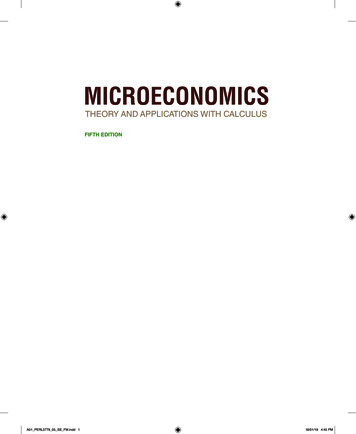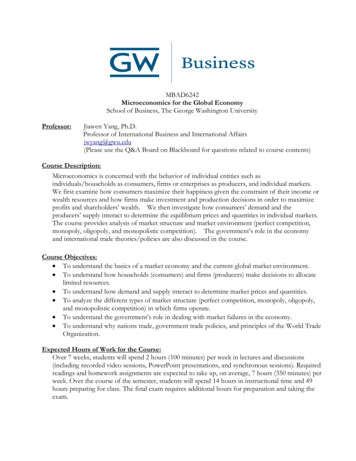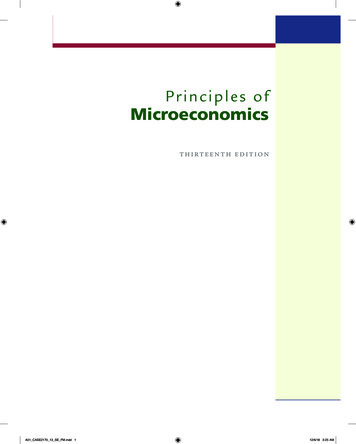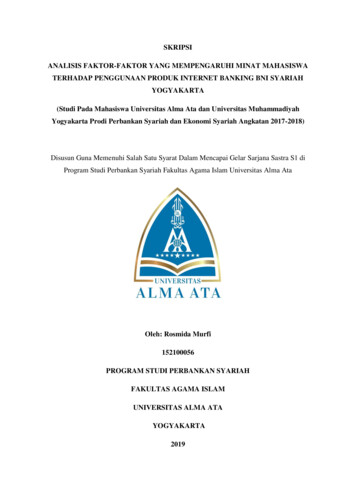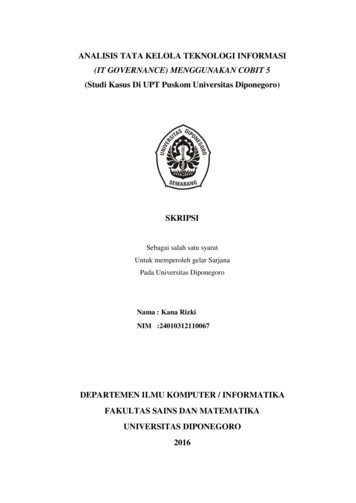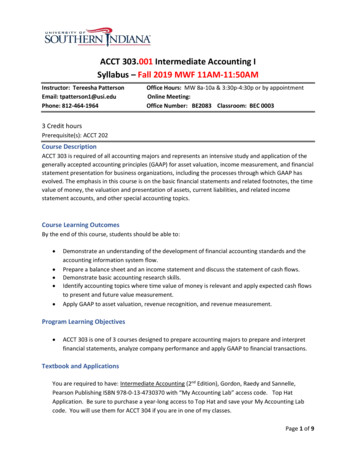
Transcription
Intermediate MicroeconomicsA Modern ApproachNinth Edition
IntermediateMicroeconomicsA Modern ApproachNinth EditionHal R. VarianUniversity of California at BerkeleyW. W. Norton & Company New York London
W. W. Norton & Company has been independent since its founding in 1923,when William Warder Norton and Mary D. Herter Norton first published lectures delivered at the People’s Institute, the adult education division of NewYork City’s Cooper Union. The firm soon expanded its program beyond the Institute, publishing books by celebrated academics from America and abroad. Bymid-century, the two major pillars of Norton’s publishing program—trade booksand college texts—were firmly established. In the 1950s, the Norton family transferred control of the company to its employees, and today—with a staff of fourhundred and a comparable number of trade, college, and professional titles published each year—W. W. Norton & Company stands as the largest and oldestpublishing house owned wholly by its employees.c 2014, 2010, 2006, 2003, 1999, 1996, 1993, 1990, 1987 by Hal R.Copyright VarianAll rights reservedPrinted in the United States of AmericaNINTH EDITIONEditor: Jack RepcheckSenior project editor: Thom FoleyProduction manager: Andy EnsorEditorial assistant: Theresia KowaraTEXnician: Hal VarianISBN 978-0-393-12 3 96 - 8W. W. Norton & Company, Inc., 500 Fifth Avenue, New York, N.Y. 10110W. W. Norton & Company, Ltd., Castle House, 75/76 Wells Street, London W1T 3QTwww.wwnorton.com1234567890
To Carol
CONTENTSPrefacexix1 The MarketConstructing a Model 1 Optimization and Equilibrium 3 The Demand Curve 3 The Supply Curve 5 Market Equilibrium 7 Comparative Statics 9 Other Ways to Allocate Apartments 11The Discriminating Monopolist The Ordinary Monopolist Rent Control Which Way Is Best? 14 Pareto Efficiency 15 Comparing Ways to Allocate Apartments 16 Equilibrium in the Long Run 17 Summary 18Review Questions 192 Budget ConstraintThe Budget Constraint 20 Two Goods Are Often Enough 21 Properties of the Budget Set 22 How the Budget Line Changes 24 TheNumeraire 26 Taxes, Subsidies, and Rationing 26Example: TheFood Stamp Program Budget Line Changes 31 Summary 31 ReviewQuestions 32
VIII CONTENTS3 PreferencesConsumer Preferences 34 Assumptions about Preferences 35 Indifference Curves 36 Examples of Preferences 37Perfect Substitutes Perfect Complements Bads Neutrals Satiation DiscreteGoods Well-Behaved Preferences 44 The Marginal Rate of Substitution 48 Other Interpretations of the MRS 50 Behavior of the MRS51 Summary 52 Review Questions 524 UtilityCardinal Utility 57 Constructing a Utility Function 58 Some Examples of Utility Functions 59Example: Indifference Curves from UtilityPerfect Substitutes Perfect Complements Quasilinear Preferences Cobb-Douglas Preferences Marginal Utility 65 Marginal Utilityand MRS 66 Utility for Commuting 67 Summary 69 ReviewQuestions 70 Appendix 70Example: Cobb-Douglas Preferences5 ChoiceOptimal Choice 73Consumer Demand 78Some Examples 78Perfect Substitutes Perfect Complements Neutrals and Bads Discrete Goods Concave Preferences Cobb-Douglas Preferences Estimating Utility Functions 83 Implications of the MRS Condition 85Choosing Taxes 87 Summary 89 Review Questions 89 Appendix 90Example: Cobb-Douglas Demand Functions6 DemandNormal and Inferior Goods 96 Income Offer Curves and Engel Curves97 Some Examples 99Perfect Substitutes Perfect Complements Cobb-Douglas Preferences Homothetic Preferences QuasilinearPreferences Ordinary Goods and Giffen Goods 104 The Price OfferCurve and the Demand Curve 106 Some Examples 107PerfectSubstitutes Perfect Complements A Discrete Good Substitutesand Complements 111 The Inverse Demand Function 112 Summary114 Review Questions 115 Appendix 115
CONTENTSIX7 Revealed PreferenceThe Idea of Revealed Preference 119 From Revealed Preference to Preference 120 Recovering Preferences 122 The Weak Axiom of Revealed Preference 124 Checking WARP 125 The Strong Axiom ofRevealed Preference 128 How to Check SARP 129 Index Numbers130 Price Indices 132Example: Indexing Social Security PaymentsSummary 135 Review Questions 1358 Slutsky EquationThe Substitution Effect 137Example: Calculating the Substitution Effect The Income Effect 141Example: Calculating the Income EffectSign of the Substitution Effect 142 The Total Change in Demand 143Rates of Change 144 The Law of Demand 147 Examples of Incomeand Substitution Effects 147Example: Rebating a Tax Example:Voluntary Real Time Pricing Another Substitution Effect 153 Compensated Demand Curves 155 Summary 156 Review Questions 157Appendix 157Example: Rebating a Small Tax9 Buying and SellingNet and Gross Demands 160 The Budget Constraint 161 Changingthe Endowment 163 Price Changes 164 Offer Curves and DemandCurves 167 The Slutsky Equation Revisited 168 Use of the Slutsky Equation 172Example: Calculating the Endowment Income EffectLabor Supply 173The Budget Constraint Comparative Statics ofLabor Supply 174Example: Overtime and the Supply of Labor Summary 178 Review Questions 179 Appendix 179
XCONTENTS10 Intertemporal ChoiceThe Budget Constraint 182 Preferences for Consumption 185 Comparative Statics 186 The Slutsky Equation and Intertemporal Choice187 Inflation 189 Present Value: A Closer Look 191 Analyzing Present Value for Several Periods 193 Use of Present Value 194Example: Valuing a Stream of Payments Example: The True Cost ofa Credit Card Example: Extending Copyright Bonds 198Example: Installment Loans Taxes 200Example: Scholarships and Savings Choice of the Interest Rate 201 Summary 202 Review Questions 20211 Asset MarketsRates of Return 203 Arbitrage and Present Value 205 Adjustmentsfor Differences among Assets 205 Assets with Consumption Returns206 Taxation of Asset Returns 207 Market Bubbles 208 Applications 209Depletable Resources When to Cut a Forest Example:Gasoline Prices during the Gulf War Financial Institutions 213 Summary 214 Review Questions 215 Appendix 21512 UncertaintyContingent Consumption 217Example: Catastrophe Bonds UtilityFunctions and Probabilities 222Example: Some Examples of UtilityFunctions Expected Utility 223 Why Expected Utility Is Reasonable224 Risk Aversion 226Example: The Demand for Insurance Diversification 230 Risk Spreading 230 Role of the Stock Market 231Summary 232 Review Questions 232 Appendix 233Example:The Effect of Taxation on Investment in Risky Assets13 Risky AssetsMean-Variance Utility 236 Measuring Risk 241 Counterparty Risk243 Equilibrium in a Market for Risky Assets 243 How ReturnsAdjust 245Example: Value at Risk Example: Ranking Mutual FundsSummary 249 Review Questions 250
CONTENTSXI14 Consumer’s SurplusDemand for a Discrete Good 252 Constructing Utility from Demand253 Other Interpretations of Consumer’s Surplus 254 From Consumer’s Surplus to Consumers’ Surplus 255 Approximating a Continuous Demand 255 Quasilinear Utility 255 Interpreting the Change inConsumer’s Surplus 256Example: The Change in Consumer’s SurplusCompensating and Equivalent Variation 258Example: Compensatingand Equivalent Variations Example: Compensating and Equivalent Variation for Quasilinear Preferences Producer’s Surplus 262 Benefit-CostAnalysis 264Rationing Calculating Gains and Losses 266 Summary 267 Review Questions 267 Appendix 268Example: AFew Demand Functions Example: CV, EV, and Consumer’s Surplus15 Market DemandFrom Individual to Market Demand 270 The Inverse Demand Function272Example: Adding Up “Linear” Demand Curves Discrete Goods273 The Extensive and the Intensive Margin 273 Elasticity 274Example: The Elasticity of a Linear Demand Curve Elasticity and Demand 276 Elasticity and Revenue 277Example: Strikes and ProfitsConstant Elasticity Demands 280 Elasticity and Marginal Revenue 281Example: Setting a Price Marginal Revenue Curves 283 Income Elasticity 284 Summary 285 Review Questions 286 Appendix 287Example: The Laffer Curve Example: Another Expression for Elasticity16 EquilibriumSupply 293 Market Equilibrium 293 Two Special Cases 294 Inverse Demand and Supply Curves 295Example: Equilibrium with Linear Curves Comparative Statics 297Example: Shifting Both CurvesTaxes 298Example: Taxation with Linear Demand and Supply Passing Along a Tax 302 The Deadweight Loss of a Tax 304Example:The Market for Loans Example: Food Subsidies Example: Subsidies inIraq Pareto Efficiency 310Example: Waiting in Line Summary 313Review Questions 313
XII CONTENTS17 MeasurementSummarize data 316Example: Simpson’s paradox Test 320 Estimating demand using experimental data 320 Effect of treatment 321Estimating demand using observational data 322Functional form Statistical model Estimation Identification 324 What can gowrong? 326 Policy evaluation 327Example: Crime and policeSummary 328 Review Questions 32918 AuctionsClassification of Auctions 331Bidding Rules Auction Design 332Example: Goethe’s auction Other Auction Forms 336Example: LateBidding on eBay Position Auctions 338Two Bidders More ThanTwo Bidders Quality Scores Should you advertise on your brand?341 Auction revenue and number of bidders 342 Problems with Auctions 343Example: Taking Bids Off the Wall The Winner’s Curse344 Stable Marriage Problem 345 Mechanism Design 346 Summary 348 Review Questions 34919 TechnologyInputs and Outputs 350 Describing Technological Constraints 351Examples of Technology 352Fixed Proportions Perfect Substitutes Cobb-Douglas Properties of Technology 354 The MarginalProduct 356 The Technical Rate of Substitution 356 DiminishingMarginal Product 357 Diminishing Technical Rate of Substitution 357The Long Run and the Short Run 358 Returns to Scale 358Example: Datacenters Example: Copy Exactly! Summary 361 ReviewQuestions 362
CONTENTS XIII20 Profit MaximizationProfits 363 The Organization of Firms 365 Profits and Stock MarketValue 365 The Boundaries of the Firm 367 Fixed and Variable Factors 368 Short-Run Profit Maximization 368 Comparative Statics370 Profit Maximization in the Long Run 371 Inverse Factor DemandCurves 372 Profit Maximization and Returns to Scale 373 RevealedProfitability 374Example: How Do Farmers React to Price Supports?Cost Minimization 378 Summary 378 Review Questions 379 Appendix 38021 Cost MinimizationCost Minimization 382Example: Minimizing Costs for Specific Technologies Revealed Cost Minimization 386 Returns to Scale and theCost Function 387 Long-Run and Short-Run Costs 389 Fixed andQuasi-Fixed Costs 391 Sunk Costs 391 Summary 392 ReviewQuestions 392 Appendix 39322 Cost CurvesAverage Costs 396 Marginal Costs 398 Marginal Costs and VariableCosts 400Example: Specific Cost Curves Example: Marginal CostCurves for Two Plants Cost Curves for Online Auctions 404 Long-RunCosts 405 Discrete Levels of Plant Size 407 Long-Run Marginal Costs408 Summary 409 Review Questions 410 Appendix 41123 Firm SupplyMarket Environments 413 Pure Competition 414 The Supply Decision of a Competitive Firm 416 An Exception 418 Another Exception419Example: Pricing Operating Systems The Inverse Supply Function 421 Profits and Producer’s Surplus 421Example: The SupplyCurve for a Specific Cost Function The Long-Run Supply Curve of a Firm425 Long-Run Constant Average Costs 427 Summary 428 ReviewQuestions 429 Appendix 429
XIV CONTENTS24 Industry SupplyShort-Run Industry Supply 431 Industry Equilibrium in the Short Run432 Industry Equilibrium in the Long Run 433 The Long-Run SupplyCurve 435Example: Taxation in the Long Run and in the Short RunThe Meaning of Zero Profits 439 Fixed Factors and Economic Rent440Example: Taxi Licenses in New York City Economic Rent 442Rental Rates and Prices 444Example: Liquor Licenses The Politicsof Rent 445Example: Farming the Government Energy Policy 447Two-Tiered Oil Pricing Price Controls The Entitlement Program Carbon Tax Versus Cap and Trade 451Optimal Production of Emissions A Carbon Tax Cap and Trade Summary 455 ReviewQuestions 45525 MonopolyMaximizing Profits 458 Linear Demand Curve and Monopoly 459Markup Pricing 461Example: The Impact of Taxes on a Monopolist Inefficiency of Monopoly 463 Deadweight Loss of Monopoly 465Example: The Optimal Life of a Patent Example: Patent Thickets Example: Managing the Supply of Potatoes Natural Monopoly 469 WhatCauses Monopolies? 472Example: Diamonds Are Forever Example:Pooling in Auction Markets Example: Price Fixing in Computer MemoryMarkets Summary 476 Review Questions 476 Appendix 47726 Monopoly BehaviorPrice Discrimination 480 First-Degree Price Discrimination 480Example: First-degree Price Discrimination in Practice Second-Degree PriceDiscrimination 483Example: Price Discrimination in Airfares Example: Prescription Drug Prices Third-Degree Price Discrimination 487Example: Linear Demand Curves Example: Calculating Optimal PriceDiscrimination Example: Price Discrimination in Academic JournalsBundling 492Example: Software Suites Two-Part Tariffs 493 Monopolistic Competition 494 A Location Model of Product Differentiation498 Product Differentiation 500 More Vendors 501 Summary 502Review Questions 502
CONTENTS XV27 Factor MarketsMonopoly in the Output Market 503 Monopsony 506Example: TheMinimum Wage Upstream and Downstream Monopolies 510 Summary512 Review Questions 513 Appendix 51328 OligopolyChoosing a Strategy 516Example: Pricing Matching Quantity Leadership 517The Follower’s Problem The Leader’s Problem PriceLeadership 522 Comparing Price Leadership and Quantity Leadership525Simultaneous Quantity Setting 525An Example of CournotEquilibrium 527 Adjustment to Equilibrium 528 Many Firms inCournot Equilibrium 529 Simultaneous Price Setting 530 Collusion 531 Punishment Strategies 533Example: Price Matching andCompetition Example: Voluntary Export Restraints Comparison of theSolutions 537 Summary 537 Review Questions 53829 Game TheoryThe Payoff Matrix of a Game 540 Nash Equilibrium 542 MixedStrategies 543Example: Rock Paper Scissors The Prisoner’s Dilemma545 Repeated Games 547 Enforcing a Cartel 548Example: Titfor Tat in Airline Pricing Sequential Games 550 A Game of EntryDeterrence 552 Summary 554 Review Questions 55530 Game ApplicationsBest Response Curves 556 Mixed Strategies 558 Games of Coordination 560Battle of the Sexes Prisoner’s Dilemma AssuranceGames Chicken How to Coordinate Games of Competition 564Games of Coexistence 569 Games of Commitment 571The Frogand the Scorpion The Kindly Kidnapper When Strength Is Weakness Savings and Social Security Example: Dynamic inefficiencyof price discrimination Hold Up Bargaining 580The UltimatumGame Summary 583 Review Questions 583
XVI CONTENTS31 Behavioral EconomicsFraming Effects in Consumer Choice 586The Disease Dilemma Anchoring Effects Bracketing Too Much Choice ConstructedPreferences Uncertainty 590Law of Small Numbers Asset Integration and Loss Aversion Time 593Discounting Self-control Example: Overconfidence Strategic Interaction and Social Norms 595Ultimatum Game Fairness Assessment of Behavioral Economics597 Summary 599 Review Questions 59932 ExchangeThe Edgeworth Box 602 Trade 604 Pareto Efficient Allocations605 Market Trade 607 The Algebra of Equilibrium 609 Walras’Law 611 Relative Prices 612Example: An Algebraic Example ofEquilibrium The Existence of Equilibrium 614 Equilibrium and Efficiency 615 The Algebra of Efficiency 616Example: Monopoly inthe Edgeworth Box Efficiency and Equilibrium 619 Implications of theFirst Welfare Theorem 621 Implications of the Second Welfare Theorem623 Summary 625 Review Questions 626 Appendix 62633 ProductionThe Robinson Crusoe Economy 628 Crusoe, Inc. 630 The Firm 631Robinson’s Problem 632 Putting Them Together 632 Different Technologies 634 Production and the First Welfare Theorem 636 Production and the Second Welfare Theorem 637 Production Possibilities 637Comparative Advantage 639 Pareto Efficiency 641 Castaways, Inc.643 Robinson and Friday as Consumers 645 Decentralized ResourceAllocation 646 Summary 647 Review Questions 647 Appendix 648
CONTENTS XVII34 WelfareAggregation of Preferences 651 Social Welfare Functions 653 WelfareMaximization 655 Individualistic Social Welfare Functions 657 FairAllocations 658 Envy and Equity 659 Summary 661 ReviewQuestions 661 Appendix 66235 ExternalitiesSmokers and Nonsmokers 664 Quasilinear Preferences and the CoaseTheorem 667 Production Externalities 669Example: PollutionVouchers Interpretation of the Conditions 674 Market Signals 677Example: Bees and Almonds The Tragedy of the Commons 678Example: Overfishing Example: New England Lobsters Automobile Pollution 682 Summary 684 Review Questions 68436 Information TechnologySystems Competition 687 The Problem of Complements 687Relationships among Complementors Example: Apple’s iPod and iTunesExample: Who Makes an iPod? Example: AdWords and AdSense LockIn 693A Model of Competition with Switching Costs Example:Online Bill Payment Example: Number Portability on Cell Phones Network Externalities 697 Markets with Network Externalities 697 Market Dynamics 699Example: Network Externalities in Computer Software Implications of Network Externalities 703Example: The YellowPages Example: Radio Ads Two-sided Markets 705A Model ofTwo-sided Markets Rights Management 706Example: Video RentalSharing Intellectual Property 708Example: Online Two-sided MarketsSummary 711 Review Questions 712
XVIII CONTENTS37 Public GoodsWhen to Provide a Public Good? 714 Private Provision of the PublicGood 718 Free Riding 718 Different Levels of the Public Good 720Quasilinear Preferences and Public Goods 722Example: PollutionRevisited The Free Rider Problem 724 Comparison to Private Goods726Voting 727Example: Agenda Manipulation The VickreyClarke-Groves Mechanism 730Groves Mechanism The VCG Mechanism Examples of VCG 732Vickrey Auction Clarke-GrovesMechanism Problems with the VCG 733 Summary 734 ReviewQuestions 735 Appendix 73538 Asymmetric InformationThe Market for Lemons 738 Quality Choice 739Choosing the Quality Adverse Selection 741 Moral Hazard 743 Moral Hazard andAdverse Selection 744 Signaling 745Example: The Sheepskin EffectIncentives 749Example: Voting Rights in the Corporation Example:Chinese Economic Reforms Asymmetric Information 754Example:Monitoring Costs Example: The Grameen Bank Summary 757 Review Questions 758Mathematical AppendixFunctions A1 Graphs A2 Properties of Functions A2 InverseFunctions A3 Equations and Identities A3 Linear Functions A4Changes and Rates of Change A4 Slopes and Intercepts A5 AbsoluteValues and Logarithms A6 Derivatives A6 Second Derivatives A7The Product Rule and the Chain Rule A8 Partial Derivatives A8Optimization A9 Constrained Optimization A10AnswersA11IndexA31
PREFACEThe success of the first eight editions of Intermediate Microeconomics haspleased me very much. It has confirmed my belief that the market wouldwelcome an analytic approach to microeconomics at the undergraduatelevel.My aim in writing the original text was to present a treatment of themethods of microeconomics that would allow students to apply these toolson their own and not just passively absorb the predigested cases describedin the text. I have found that the best way to do this is to emphasizethe fundamental conceptual foundations of microeconomics and to provideconcrete examples of their application rather than to attempt to providean encyclopedia of terminology and anecdote.A challenge in pursuing this approach arises from the lack of mathematical prerequisites for economics courses at many colleges and universities.The lack of calculus and problem-solving experience in general makes itdifficult to present some of the analytical methods of economics. However,it is not impossible. One can go a long way with a few simple facts aboutlinear demand and supply functions, and some elementary algebra. It isperfectly possible to be analytical without being excessively mathematical.The distinction is worth emphasizing. An analytical approach to economics is one that uses rigorous, logical reasoning. This does not necessarily require the use of advanced mathematical methods. The languageof mathematics certainly helps to ensure a rigorous analysis and using itis undoubtedly the best way to proceed when possible, but it may not beappropriate for all students.
XXPREFACEMany undergraduate majors in economics are students who should knowcalculus, but don’t—at least, not very well. For this reason I have kept calculus out of the main body of the text. However, I have provided completecalculus appendices to many of the chapters. This means that the calculusmethods are there for the students who can handle them, but they do notpose a barrier to understanding for the others.I think that this approach manages to convey the idea that calculus isnot just a footnote to the argument of the text, but is instead a deeperway to examine the same issues that one can also explore verbally andgraphically. Many arguments are much simpler with a little mathematics,and all economics students should learn that. In many cases I’ve foundthat with a little motivation, and a few nice economic examples, studentsbecome quite enthusiastic about looking at things from an analytic perspective.For students who are comfortable with calculus, I also offer a version ofthe text that incorporates the material in the chapter appendices into thebody of chapters.There are several other innovations in this text. First, the chapters aregenerally very short. I’ve tried to make most of them roughly “lecturesize,” so that they can be read in one sitting. I have followed the standardorder of discussing first consumer theory and then producer theory, butI’ve spent a bit more time on consumer theory than is normally the case.This is not because I think that consumer theory is necessarily the mostimportant part of microeconomics; rather, I have found that this is thematerial that students find the most mysterious, so I wanted to provide amore detailed treatment of it.Second, I’ve tried to put in a lot of examples of how to use the theoriesdescribed here. In most books, students look at a lot of diagrams of shiftingcurves, but they don’t see much algebra, or much calculation of any sort forthat matter. But it is the algebra that is used to solve problems in practice.Graphs can provide insight, but the real power of economic analysis comesin calculating quantitative answers to economic problems. Every economicsstudent should be able to translate an economic story into an equation ora numerical example, but all too often the development of this skill isneglected. For this reason I have also provided a workbook that I feel isan integral accompaniment to this book. The workbook was written withmy colleague Theodore Bergstrom, and we have put a lot of effort intogenerating interesting and instructive problems. We think that it providesan important aid to the student of microeconomics.Third, I believe that the treatment of the topics in this book is moreaccurate than is usually the case in intermediate micro texts. It is truethat I’ve sometimes chosen special cases to analyze when the general caseis too difficult, but I’ve tried to be honest about that when I did it. Ingeneral, I’ve tried to spell out every step of each argument in detail. Ibelieve that the discussion I’ve provided is not only more complete and more
PREFACE XXIaccurate than usual, but this attention to detail also makes the argumentseasier to understand than the loose discussion presented in many otherbooks.There Are Many Paths to Economic EnlightenmentThere is more material in this book than can comfortably be taught in onesemester, so it is worthwhile picking and choosing carefully the materialthat you want to study. If you start on page 1 and proceed through thechapters in order, you will run out of time long before you reach the endof the book. The modular structure of the book allows the instructor agreat deal of freedom in choosing how to present the material, and I hopethat more people will take advantage of this freedom. The following chartillustrates the chapter dependencies.The andIntertemporal ChoiceAsset MarketsConsumer's SurplusMarket DemandRisky AssetsSlutsky EquationBuying and SellingEquilibriumAuctionsProfit MaximizationRevealed roductionWelfareCost MinimizationCost CurvesFirm SupplyIndustry SupplyMonopoly BehaviorMonopolyOligopolyFactor MarketsExternalitiesGame TheoryPublic GoodsGame ApplicationsAsymmetric InformationThe darker colored chapters are “core” chapters—they should probably becovered in every intermediate microeconomics course. The lighter-coloredchapters are “optional” chapters: I cover some but not all of these everysemester. The gray chapters are chapters I usually don’t cover in my course,but they could easily be covered in other courses. A solid line going fromChapter A to Chapter B means that Chapter A should be read before
XXIIPREFACEchapter B. A broken line means that Chapter B requires knowing somematerial in Chapter A, but doesn’t depend on it in a significant way.I generally cover consumer theory and markets and then proceed directlyto producer theory. Another popular path is to do exchange right afterconsumer theory; many instructors prefer this route and I have gone tosome trouble to make sure that this path is possible.Some people like to do producer theory before consumer theory. This ispossible with this text, but if you choose this path, you will need to supplement the textbook treatment. The material on isoquants, for example,assumes that the students have already seen indifference curves.Much of the material on public goods, externalities, law, and informationcan be introduced earlier in the course. I’ve arranged the material so thatit is quite easy to put it pretty much wherever you desire.Similarly, the material on public goods can be introduced as an illustration of Edgeworth box analysis. Externalities can be introduced rightafter the discussion of cost curves, and topics from the information chaptercan be introduced almost anywhere after students are familiar with theapproach of economic analysis.Changes for the Ninth EditionI have added a new chapter on measurement which describes some of theissues involved in estimating economic relationships. The idea is to introduce the student to some basic concepts from econometrics and try tobridge the theoretical treatment in the book with the practical problemsencountered in practice.I have offered some new examples drawn from Silicon Valley firms suchas Apple, eBay, Google, Yahoo, and others. I discuss topics such as thecomplementarity between the iPod and iTunes, the positive feedback associated with companies such as Facebook, and the ad auction models usedby Google, Microsoft, and Yahoo. I believe that these are fresh and interesting examples of economics in action.I’ve also added an extended discussion of mechanism design issues, including two-sided matching markets and the Vickrey-Clarke-Groves mechanisms. This field, which was once primarily theoretical in nature, has nowtaken on considerable practical importance.The Test Bank and WorkbookThe workbook, Workouts in Intermediate Microeconomics, is an integralpart of the course. It contains hundreds of fill-in-the-blank exercises thatlead the students through the steps of actually applying the tools they havelearned in the textbook. In addition to the exercises, Workouts contains acollection of short multiple-choice quizzes based on the workbook problemsin each chapter. Answers to the quizzes are also included in Workouts.
PREFACEXXIIIThese quizzes give a quick way for the student to review the material heor she has learned by working the problems in the workbook.But there is more . . . instructors who have adopted Workouts for theircourse can make use of the Test Bank offered with the textbook. The TestBank contains several alternative versions of each Workouts quiz. Thequestions in these quizzes use different numerical values but the same internal logic. They can be used to provide additional problems for studentsto work on, or to give quizzes to be taken in class. Grading is quick andreliable because the quizzes are multiple choice and can be graded electronically.In our course, we tell the students to work through all the quiz questionsfor each chapter, either by themselves or with a study group. Then duringthe term we have a short in-class quiz every other week or so, using thealternative versions from the Test Bank. These are essentially the Workouts quizzes with different numbers. Hence, students who have done theirhomework find it easy to do well on the quizzes.We firmly believe that you can’t learn economics without working someproblems. The quizzes provided in Workouts and in the Test Bank makethe learning process much easier for both the student and the teacher.A hard copy of the Test Bank is available from the publisher, as is thetextbook’s Instructor’s Manual, which includes my teaching suggestionsand lecture notes for each chapter of the textbook, and solutions to theexercises in Workouts.A number of other useful ancillaries are also available with this textbook. These include a comprehensive set of PowerPoint slides, as wellas the Norton Economic News Service, which alerts students to economicnews related to specific material in the textbook. For information onthese and other ancillaries, please visit the homepage for the book athttp://www.wwnorton.com/varian.The Production of the BookThe entire book was typeset by the author using TEX, the wonderful typesetting system designed by Donald Knuth. I worked on a Linux systemand using GNU emacs for editing, rcs for version control and the TEXLive system for processing. I used makeindex for the index, and TrevorDarrell’s psfig software for inserting the diagrams.The book design was by Nancy Dale Muldoon, with some modificationsby Roy Tedoff and the author. Jack Repchek coordinated the whole effortin his capacity as
Ninth Edition Hal R. Varian . Ultimatum Game Fairness Assessment of Behavioral Economics 597 Summary 599 ReviewQuestions 599 32 Exchange The Edgeworth Box 602 T


